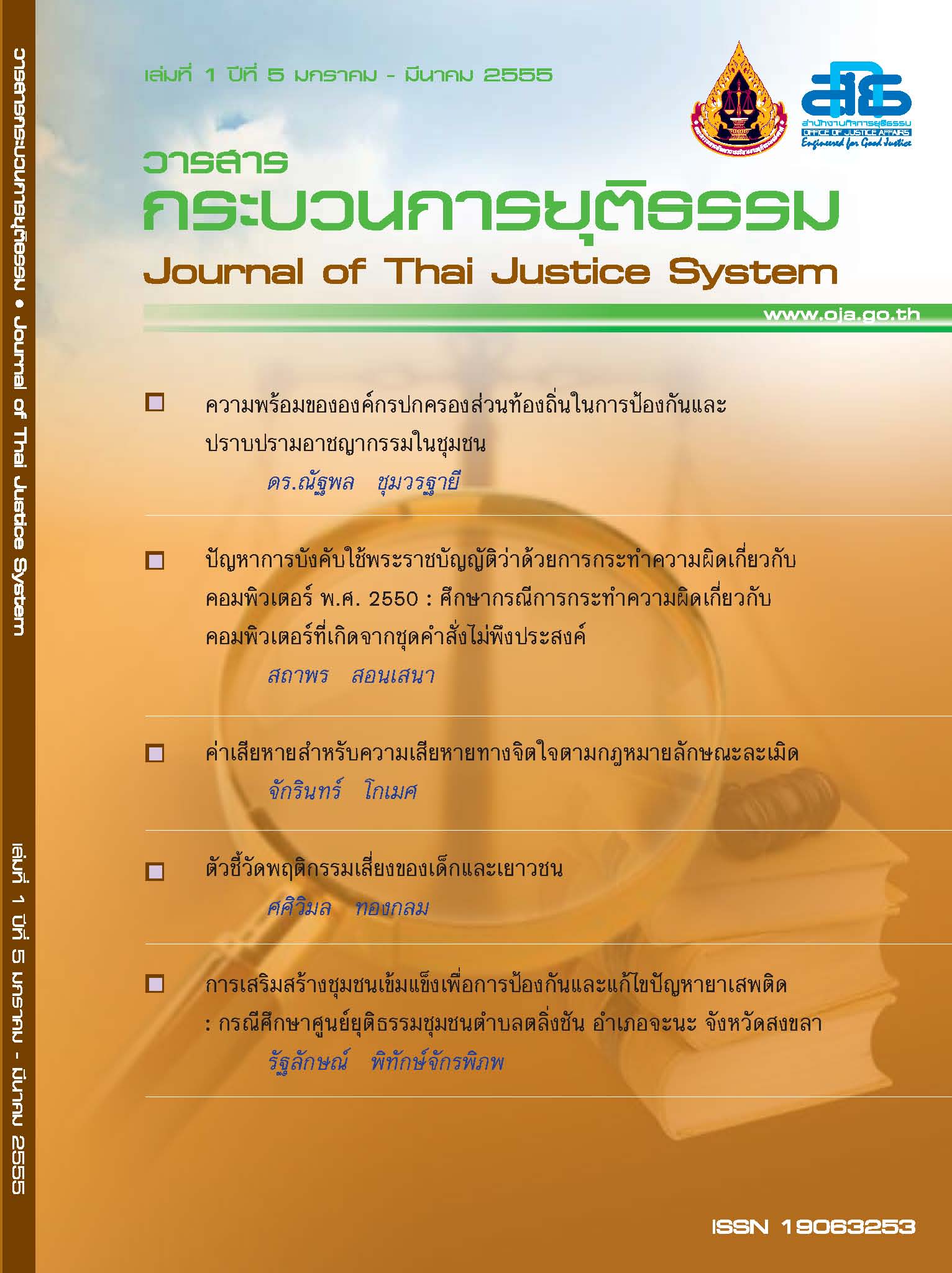การเสริมสร้างชุมชนเข้มแข็งเพื่อการป้องกันและแก้ไขปัญหายาเสพติด : กรณีศึกษาศูนย์ยุติธรรมชุมชนตำบลตลิ่งชัน อำเภอจะนะ จังหวัดสงขลา
Main Article Content
บทคัดย่อ
การวิจัยครั้งนี้มีวัตถุประสงค์ เพื่อศึกษาการบริหารจัดการการดำเนินงานปัจจัยแห่งความสำเร็จ และปัญหาอุปสรรคของศูนย์ยุติธรรมชุมชนจำบลตลิ่งชันในการป้องกันและแก้ไขปัญหายาเสพติด การเก็บแบบสอบถามแบ่งเป็น 2 ส่วน คือ เชิงปริมาณโดยมีกลุ่มตัวอย่าง จำนวน 187 คน ได้แก่ สมาชิกเครือข่าย อาสาสมัครและกรรมการของศูนย์ยุติธรรมชุมชน เชิงคุณภาพ มีกลุ่มอย่างจำนวน 5 คน ได่แก่ ประธานกรรมการศูนย์ยุติธรรมชุมชน 1 คน รองประธานศูนย์ยุติธรรมชุมชน 2 คน และกรรมการ ศูนย์ยุติธรรมชุมชน 2 คน การวิเคราะห์เป็นการหาค่าสถิติพื้นฐาน ด้วยค่าความถี่ร้อยละ การวิเคราะห์ความสัมพันธ์ของตัวแปรโดยใช้สถิติการวิเคราะห์ความถดถอยพหุคูณ (Multiple Regression Analysis) ในส่วนการวิเคราะห์ข้อมูลเชิงคุณภาพใช้วิธีการวิเคราะห์เนื้อหา (Content Analysis) ตามประเด็นคำถามที่สร้างขึ้น
ผลการวิจัยพบว่าปัจจัยที่มีความสัมพันธ์ต่อการเสริมสร้างชุมชนเข้มแข็งเพื่อป้องกันและแก้ไขปัญหายาเสพติด ได้แก่ การมีส่วนร่วมในการป้องกันและแก้ไขปัญหายาเสพติด ได้แก่ การมีส่วนร่วมในการป้องกันและแก้ไขปัญหายาเสพติดโดยมีความสัมพันธ์กับความสำเร็จในการเสริมสร้างชุมชนเข้มแข็ง ร้อยละ 18.6 (Beta = 0186) และมีนัยสำคัญทางสถิติที่ระดับ 0.05 (P = 0.035) โดยที่ตัวแปรที่ได้จากการวิจัยสามารถใช้พยากรณืการเสริมสร้างชุมชนเข้มแข็งเพื่อป้องกันและแก้ไขปัญหายาเสพติด
ข้อเสนอแนะจากการวิจัยแบ่งเป็น 2 ส่วนได้แก่ เชิงนโยบายและเชิงปฏิบัติการ โดยในส่วนของนโยบายจะเน้นที่การสร้างเครือข่ายความร่วมมือกับองค์กรที่เกี่ยวข้อง อย่างกรมคุมประพฤติซึ่งเป็นองค์กรหลักในการดูแลการบริหารจัดการของศูนย์ยุติธรรมชุมชน และวางนโยบายที่มีความชัดเจนในการบริหารงานในรูปแบบของศูนย์ยุติธรรมชุมชน ในส่วนของเชิงปฏิบัติการจะเน้นที่การประสานงาน การจัดกิจกรรม ความสอดคล้องในการปฏิบัติงานและการเข้าถึงคนในชุมชนเพื่อรับทราบถึงปัญหาและหาแนวทางในการดำเนินการแก้ขไปัญหานั้นเพื่อนำไปกสู่ความสำเร็จในการเสริมสร้างชุมชนเข้มแข็งให้มากยิ่งขึ้น
Article Details
ต้นฉบับที่ได้รับการตีพิมพ์ในวารสาร เป็นลิขสิทธิ์ของวารสารกระบวนการยุติธรรม แต่ความคิดเห็นที่ปรากฏในเนื้อหาของบทความในวารสารกระบวนการยุติธรรม ถือเป็นความรับผิดชอบของผู้เขียนแต่เพียงผู้เดียว
เอกสารอ้างอิง
กระทรวงยุติธรรม (2551). คู่มือเครือข่ายยุติธรรมชุมชน. กรุงเทพฯ:กระทรวงยุติธรรม.
คมสัน ศรีงิ้ว (2548). การศึกษาเปรียบเทียบชุมชนเข้มแข็งกับการปลอดยาเสพติดระหว่างตำบลคลองตะเคียนกับตำบลสำเภาล่มอำเภอพระนครศรีอยุทธยา จังหวัดพระนครศรีอยุธยา. วิทยานิพนธ์ปริญญาศิลปศาสตรมหาบัณฑิต สาขารัฐศาสตร์ บัณฑิตวิทยาลัย มหาวิทยาลัยเกษตรศาสตร์.
จุฑารัตน์ เอื้ออำนวย. และคณะ. ร่างรายงานการวิจัยเรื่องยุติธรรมชุมชน:การเปิดพื้นที่ของชุมชนในการอำนวยความมยุติธรรม. สำนักงานกองทุนสนับสนุนการวิจัย(สกว.)(อัดสำเนา).
ดวงเดือน จุลกรานต์ (2548). การมีส่วนร่วมของคณะกรรมการชุมชนในการดำเนินงานการป้องกัน และแก้ไขปัญหายาเสพติดในชุมชน เมือง : กรณีศึกษาแขวงหิรัญรูจี เขตธนบุรี กรุงเทพมหานคร. ภาคนิพนธ์ศิลปศาสตรมหาบัณฑิต คณะพัฒนสังคม สถาบันบัณฑิต พัฒนบริหารศาสตร์.
ทัศนีย์ อุวรัตน์ (2548). รายงานการวิจัย เชิงปฏิบัติการแบบมีส่วนร่วม โครงการเสริมสร้างและพัฒนาเครือข่ายยุติธรรมชุมชนจังหวัดเชียงใหม่. กรมคุ้มครองสิทธิและเสรีภาพ กระทรวงยุติธรรม.
นัยน์ปพร สุภากรณ์ (2550). ความผูกพันกับชุมชนของประชาชนในชุมชนแขวงกัลยาณ์เขต ธนบุรี กรุงเทพมหานคร. วิทยานิพนธ์ปริญญาศิลปศาสตรมหาบัณฑิต (รัฐศาสตร์) บัณฑิตวิทยาลัย มหาวิทยาลัยเกษตรศาสตร์.
นฤมล บรรจงจิตร์ (2549). รายงานฉบับสมบูรณ์ โครงการกระบวนการเสริมสร้างความเข้มแข็งของชุมชนเพื่อการแก้ไขปัญาหความยากจน. สถาบันวิจัยสังคม จุฬาลงกรณ์มหาวิทยาลัย.
ประดิษฐ์ มะกรูดทอง (2543). การสร้างเขตปลอดยาเสพติดในชุมชน:ศึกษากรณีชุมชนริมคลองลาดพร้าวภาวนา. วิทยานิพนธ์ปริญญาศิลปศาสตรมหาบัณฑิต (รัฐศาสตร์) บัณฑิตวิทยาลัย มหาวิทยาลัยเกษตรศาสตร์.
มนตรี กรรพุมมาลย์ (2546). การศึกษาองค์กรชุมชนเข้มแข็ง : กรณีศึกษาชุมชนในเขตเทศบาลตำบลอุโมงค์ อำเภอเมืองจังหวัดลำพูน. เอกสารประกอบการประชุม วิทชาการระดับชาติ สาขาสังคมวิทยา ครั้งที่ 2 พลังสังคมไทยในทศวรรษหน้า: ทางเลือกกับความเป็นจริง 19-20 ธันวาคม 2546.
วิชัย พันธุ์ภักดี (2548). ปัจจัยที่มีผลต่อความสำเร็จในการแก้ไขปัญหายาเสพติดอย่างยั่งยืนของอำเภอภูเขียว จังหวัดชัยภูมิ. ปริญญารัฐประศาสนศาสตรมหาบัณฑิต สาขาวิชา นโยบายสาธารณะ มหาวิทยาลัยมหาสารคาม.
วิรัช วิรัชนิภาวรรณ (2547). การบริหารและจัดการเทศบาลในยุคปฏิรูปการเมือง. กรุงเทพฯ : สำนักพิมพ์ โฟร์เฟซ.
สุณีย์ กัลยะจิตร (2553). ร่างรายงานการวิจัยโครงการ การติดตามและประเมิณผลงานยุติธรรมชุมชน. กรมคุมประพฤติ กระทรวงยุติธรรม.
สุดสงวน สุธีสงวน (2547). อาชญาวิทยาและงานสังคมสงเคราะห์. (พิมพ์ครั้งที่ 2). กรุงเทพ. โรงพิมพ์มหาวิทยาลัยธรรมศาสตร์.
สุชาดา จักรพิสุทธิ์ (2547). การศึกษาทางเลือกของชุมชน. วารสารศึกษาศาสตร์มหาวิทยาลัยขอนแก่น. (มิถุนายน - สิงหาคม 2547).
อคิน รพีพัฒน์ (2547). การมีส่วนร่วมของประชาชนในงานพัฒนา. กรุงเทพฯ. ศูนย์การศึกษานโยบายสาธารณสุข,
ภาษาอังกฤษ
Cohen, J.M. and Uphoff, N.T. (1981). Rural Development Participation: Concept and Measures for Project Design Implementation and Evaluation. Rural Development Committee Center for International Studies, Cornell University.
Fornaroff, A. (1980). Community involvment in Health System for Primary Health Care. Genava : World Health Organization.
Koufman, H.F. March, (1949). Paricipation Organized Acticities in Selected Kentucky Localities. Agricultural Experiment Station Bulletins.
Reeder, W.W. (1974). Some Aspects of The Information Social Participation of Farm Families in New York State. New York : Unpublished Ph.D Dissertation, Cornell University.
United Nation, Department of Internation Economic and Social Affair. (1981). Popular Participation as a Strategy for Promoting Community Level Action and Nation Development. Report of The Meeting for The Adhoc Group oof Expert. New York : United Nation.


